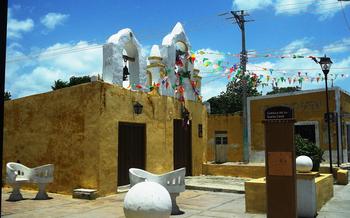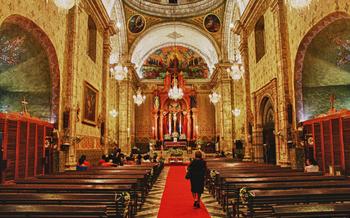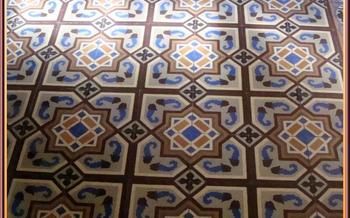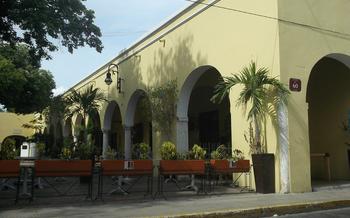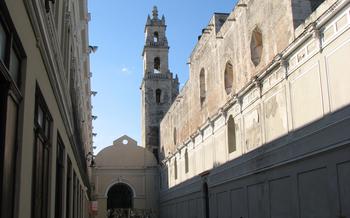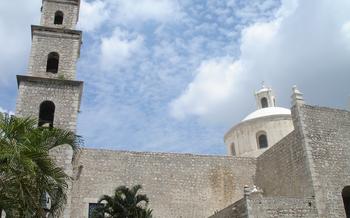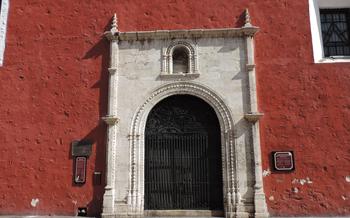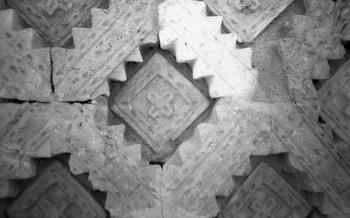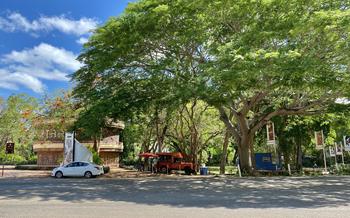
Mérida Cathedral
- Historical Significance
- Plaza Grande: The Vibrant Square Where the Cathedral Stands
- A Glimpse into the Past: The Cathedral's Construction
- Exploring the Cathedral's Majestic Interior
- The Altar and the Altarpieces: A Masterpiece of Baroque Art
- The Sacristy: A Hidden Gem Within the Cathedral
- The Bell Tower: A Symbol of Faith and Resilience
- The Crypts: A Journey into the Cathedral's Past
- Religious Festivals and Solemn Ceremonies
- Inside Tips: How to Make the Most of Your Visit
- Nearby Attractions: Enhancing Your Mérida Experience
- The Cathedral's Role in Local Celebrations
- Sustainability Initiatives: Preserving the Cathedral's Legacy
- Insider Tip: A Hidden Viewpoint for Unique Photos
Historical Significance
The Mérida Cathedral, a majestic testament to the city's rich history, stands as a beacon of faith and cultural heritage in the heart of Mérida, Yucatan. Its story begins in the 16th century when Spanish conquistadors arrived on the shores of the Yucatán Peninsula. Determined to establish their dominance, they constructed a small church on the site of an ancient Maya temple, marking the inception of the cathedral's legacy. Over the centuries, the church underwent several transformations, reflecting the evolving religious and architectural landscape of Mérida. In the 18th century, a grander cathedral was erected, incorporating elements of Baroque and Renaissance styles. Today, the Mérida Cathedral stands as an enduring symbol of the city's colonial past and a vibrant center of religious and cultural life.
Plaza Grande: The Vibrant Square Where the Cathedral Stands
The Mérida Cathedral is not just a religious landmark but also an integral part of the city's main square, the Plaza Grande. This lively square serves as a gathering place for locals and tourists, offering a vibrant atmosphere and a glimpse into Mérida's rich history.
The Plaza Grande is surrounded by colonial-era buildings, including the Palacio de Gobierno, the Casa de Montejo, and the Museo de la Ciudad de Mérida. These buildings, with their colorful facades and intricate architectural details, create a harmonious backdrop for the cathedral.
In the center of the square stands a beautiful fountain, adorned with sculptures and surrounded by lush vegetation. This fountain is a popular spot for locals to relax and enjoy the shade on a hot day.
The Plaza Grande is a bustling hub of activity, where street vendors sell souvenirs and local delicacies, musicians entertain passersby, and children play around the fountain. It is a great place to soak up the local culture and experience the lively atmosphere of Mérida.
Throughout the year, the Plaza Grande hosts various events and festivals. During Christmas, the square is illuminated with festive lights, and a large Christmas tree is set up in front of the cathedral. During the annual carnival, the square is filled with colorful parades, music, and dancing.
A Glimpse into the Past: The Cathedral's Construction
The construction of the Mérida Cathedral spanned nearly two centuries, beginning in 1561 and concluding in 159The initial structure, a modest church, was replaced by a more ambitious project in 156However, the construction faced numerous challenges, including a lack of resources, skilled labor, and frequent attacks by pirates.
Despite these obstacles, the cathedral gradually took shape, incorporating architectural influences from Gothic, Renaissance, and Baroque styles. The cathedral's design was largely influenced by the Spanish conquistadors, who brought their own architectural traditions to the region. The cathedral's construction also reflects the blending of European and Mayan influences, as skilled Mayan builders were employed in the project.
During its construction, the cathedral witnessed numerous historical events, including the arrival of the Spanish conquistadors, the establishment of the Inquisition, and the growth of Mérida as a prominent city in the Yucatán Peninsula. The cathedral's story is intertwined with the history of the city and the region, making it a living testament to Mérida's rich past.
Exploring the Cathedral's Majestic Interior
As you step through the grand entrance of the Mérida Cathedral, you are greeted by a breathtaking spectacle of architectural mastery. The interior of the cathedral is a symphony of grandeur, adorned with intricate details and awe-inspiring features that captivate the senses.
Notable Features of the Interior:
-
Impressive Nave: The cathedral's nave, with its soaring height and elegant arches, creates a sense of spaciousness and reverence. The intricate ribbed vaults overhead add a touch of Gothic influence to the predominantly Renaissance style of the cathedral.
-
Elaborate Altarpieces: The cathedral boasts several stunning altarpieces, each a masterpiece of Baroque art. The main altarpiece, dedicated to the Assumption of Mary, is a sight to behold, with its intricate carvings, gold leaf embellishments, and vibrant colors.
-
Religious Symbolism: Every corner of the cathedral is adorned with religious symbolism, from the stained glass windows depicting biblical scenes to the intricate carvings on the choir stalls. These symbols serve as a testament to the cathedral's deep-rooted Catholic faith and its role as a center of religious devotion.
Ceiling Paintings and Stained Glass Windows:
-
Heavenly Murals: The cathedral's ceiling is adorned with magnificent frescoes depicting scenes from the life of Jesus Christ and the Virgin Mary. These vibrant paintings, with their rich colors and intricate details, transport visitors to a realm of divine beauty.
-
Stained Glass Splendor: The cathedral's stained glass windows are a symphony of light and color. Each window tells a different story from the Bible, casting a warm glow onto the interior and creating an ethereal atmosphere.
Visiting Hours and Dress Code:
-
Visiting Information: The Mérida Cathedral is open to visitors daily from morning until evening. While admission is free, donations are welcome to contribute to the cathedral's upkeep and preservation.
-
Dress Code: As a place of worship, visitors are expected to dress respectfully. Shoulders and knees should be covered, and revealing clothing is discouraged.
The Altar and the Altarpieces: A Masterpiece of Baroque Art
The altar of the Mérida Cathedral is a stunning masterpiece of Baroque art, a testament to the skill and artistry of the artisans who created it. Its intricate carvings, gold leaf embellishments, and vibrant colors captivate the eye, making it one of the most remarkable sights within the cathedral.
The history of the altar is as fascinating as its appearance. Constructed in the 18th century, it was commissioned by Bishop Juan Cano de la Torre, who sought to create a grand and impressive centerpiece for the cathedral. The altar was designed by the renowned architect Juan Miguel de Agüero, who drew inspiration from the Baroque style prevalent in Europe at the time.
One of the most striking features of the altar is its unique blend of European and Mayan influences. The carvings depict scenes from the life of Christ and the saints, while also incorporating elements of Mayan iconography and symbolism. This fusion of cultures creates a truly unique and captivating work of art.
Artisans employed various techniques, including wood carving, gilding, and painting, to create the altar and its altarpieces. The result is a masterpiece of Baroque art, showcasing the exceptional skills and craftsmanship of the era. The altar's beauty and significance make it a must-see attraction for visitors to the Mérida Cathedral.
The Sacristy: A Hidden Gem Within the Cathedral
Beyond the main altar, a concealed doorway leads to the sacristy, a treasure trove of religious artifacts and historical relics. This sacred chamber, reserved for the clergy, once served as a preparation room for priests before mass. Today, it unveils a collection of priceless vestments, ornate chalices, and intricate gold and silverwork, each piece a testament to the artistry and devotion of past generations.
Amidst the resplendent display, a 17th-century wooden chest, intricately carved with biblical scenes, holds particular significance. Legend has it that this chest once belonged to the conquistador Francisco de Montejo, who led the Spanish conquest of Yucatán. Its presence here symbolizes the intertwining of religious and secular history within the cathedral's walls.
Another highlight of the sacristy is the collection of paintings depicting scenes from the life of Christ and the saints. These works, created by renowned local artists, offer a glimpse into the religious devotion and artistic traditions of Mérida's colonial past. The sacristy also houses a collection of rare books and manuscripts, including some dating back to the early days of the Spanish conquest.
Access to the sacristy is typically restricted, but guided tours may offer a glimpse into this hidden chamber. Visitors who are fortunate enough to enter will be rewarded with a deeper understanding of the cathedral's rich history and the enduring faith of the people of Mérida.
The Bell Tower: A Symbol of Faith and Resilience
Ascend the spiral staircase of the bell tower for a remarkable journey into the heavens. Each step brings you closer to the captivating views that await atop this architectural marvel. The bell tower stands as a beacon of faith and resilience, its sturdy walls enduring the trials of time. From its lofty heights, the panoramic vistas of Mérida unfold before your eyes, a tapestry of vibrant colors and captivating landmarks.
As you reach the summit, the melodious chimes of the bells serenade you, their harmonious tunes echoing through the city's heart. These bells, crafted by skilled artisans, have borne witness to countless moments in Mérida's history, marking the passage of time and heralding both joyous and somber occasions. Their resonant tones reverberate through the air, serving as a reminder of the enduring spirit of this sacred place.
The Crypts: A Journey into the Cathedral's Past
Beneath the grandeur of the Mérida Cathedral lies a hidden realm known as the crypts. These subterranean chambers serve as a sacred resting place for notable figures who have played a significant role in the history of the cathedral and the city itself. Delving into the crypts is like embarking on a journey through time, unveiling the secrets and stories of those who came before us.
The crypts are accessible through a discreet entrance, inviting visitors to descend into the depths of the cathedral. As you navigate through the dimly lit corridors, a sense of reverence and awe fills the air. The walls are adorned with intricate carvings and inscriptions, each telling a tale of the past.
Among the most notable figures buried in the crypts is Bishop Crescencio Carrillo y Ancona, the first bishop of Yucatán. His remains lie in an elaborate tomb, a testament to his dedication to the church and his contributions to the city. Other prominent individuals, including priests, benefactors, and civic leaders, also found their final resting place within these hallowed halls.
Visiting the crypts is an opportunity to connect with the rich history of Mérida Cathedral and pay homage to those who have shaped its legacy. It is a reminder of the deep spiritual and cultural roots that run beneath the surface of this magnificent edifice.
Religious Festivals and Solemn Ceremonies
The Mérida Cathedral serves as a vibrant spiritual center for the city, hosting a multitude of religious festivals and solemn ceremonies throughout the year. These occasions not only showcase the cathedral's religious significance but also offer a glimpse into the deep-rooted faith and traditions of the local community.
One of the most prominent celebrations is the annual Feast of the Assumption, held on August 15th. This festival honors the Virgin Mary's ascent into heaven and attracts thousands of pilgrims and visitors to the cathedral. The day is marked by grand processions, solemn masses, and colorful festivities that fill the streets with joy and devotion.
During Holy Week, the cathedral becomes the epicenter of religious observances, with daily services and processions commemorating the Passion of Christ. The somber atmosphere and the reenactment of the Stations of the Cross create a powerful spiritual experience for believers.
Other notable events include the Feast of the Virgin of Guadalupe, celebrated on December 12th, and the Feast of Corpus Christi, which features elaborate processions with flower-adorned altars set up along the city streets.
Attending these religious festivals and ceremonies offers a unique opportunity to witness the vibrant faith and cultural heritage of the local community. Visitors are welcome to participate in the celebrations, showing respect for the sacredness of the occasion.
Inside Tips: How to Make the Most of Your Visit
To fully immerse yourself in the history and beauty of Mérida Cathedral, here are some insider tips to enhance your visit:
- Timing is everything: Plan your visit for early morning or late afternoon to avoid the midday heat and crowds.
- Guided tours: Take advantage of guided tours or audio guides to gain insights into the cathedral's history, architecture, and religious significance.
- Respect the sacred space: Remember that this is an active place of worship, so be respectful of ongoing religious ceremonies and maintain a quiet and reverent demeanor.
- Capture the beauty: Don't forget your camera to capture the stunning beauty of the cathedral's exterior and interior. Use a wide-angle lens to capture the grandeur of the architecture and a tripod for stable shots in low-light conditions.
Nearby Attractions: Enhancing Your Mérida Experience
The area surrounding the Mérida Cathedral is a treasure trove of cultural and historical attractions that will further enhance your experience. Just a stone's throw away, the imposing Palacio de Gobierno, with its grand architecture and historical murals, invites you to delve deeper into Yucatán's rich past. Admire the stunning paintings that adorn its walls, depicting significant events and personalities that shaped the region's history.
Strolling through the Plaza de la Independencia, you'll find yourself surrounded by vibrant energy and bustling activity. Take a moment to relax on one of the benches beneath the shade of the trees, watching the world go by. Marvel at the intricate details of the surrounding buildings, each with its own unique story to tell.
For a deeper dive into Mérida's cultural heritage, visit the Museo de la Ciudad de Mérida, housed in a beautiful 18th-century mansion. Explore its fascinating exhibits that showcase the city's history, from its pre-Columbian roots to its colonial past and modern-day identity. Don't miss the opportunity to learn about the customs, traditions, and daily life of the people who have called Mérida home throughout the centuries.
And to truly immerse yourself in the local flavor, venture into the nearby markets. Here, you'll find an array of fresh produce, colorful handicrafts, and traditional Yucatecan delicacies. Engage with the friendly vendors, who are always happy to share stories and recommendations. Indulge in the local cuisine, savoring the unique flavors and aromas that have made Yucatán famous for its culinary delights.
The Cathedral's Role in Local Celebrations
The Mérida Cathedral is not only a religious landmark but also an integral part of the city's cultural and social fabric. It serves as a central stage for various celebrations and events throughout the year, reflecting the deep-rooted traditions and customs of Mérida.
During the Christmas season, the cathedral transforms into a resplendent sight, adorned with vibrant decorations and illuminating lights. Locals gather for traditional posadas, reenacting the journey of Mary and Joseph in search of shelter. The air reverberates with the joyful sounds of Christmas carols and the sweet aroma of traditional dishes.
Easter is another significant period where the cathedral becomes the focal point of solemn ceremonies and processions. During Holy Week, the streets of Mérida come alive with religious parades showcasing elaborate floats and costumed participants. Locals and visitors alike witness the reenactment of the Passion of Christ, culminating in the solemn Good Friday procession.
Beyond these major religious events, the cathedral also hosts numerous other celebrations and gatherings. Traditional dance performances, musical concerts, and art exhibitions are frequently held within its hallowed halls, fostering a vibrant cultural scene in the heart of the city.
Sustainability Initiatives: Preserving the Cathedral's Legacy
The Mérida Cathedral is not only a religious and cultural landmark but also a testament to the city's commitment to sustainability. Recognizing the significance of preserving this architectural gem for future generations, the cathedral authorities have implemented several restoration and conservation initiatives. These efforts aim to maintain the cathedral's structural integrity, protect its unique features, and promote sustainable practices in its management.
Regular maintenance and restoration work is carried out to address any signs of wear and tear, ensuring the cathedral's longevity. These efforts involve cleaning and repairing the exterior facade, maintaining the interior spaces, and preserving the intricate artwork and decorations.
Moreover, the cathedral has embraced sustainable practices in its daily operations. Energy-efficient lighting systems have been installed to reduce electricity consumption, and water conservation measures are implemented to minimize water usage. The cathedral's grounds are meticulously maintained using environmentally friendly practices, promoting biodiversity and reducing the ecological footprint.
By educating visitors about the importance of preservation and sustainability, the cathedral actively engages the community in its conservation efforts. Guided tours often highlight the cathedral's sustainable practices, inspiring visitors to adopt similar principles in their own lives.
These sustainability initiatives demonstrate the cathedral's commitment to preserving its heritage while respecting the environment. By embracing responsible practices, the Mérida Cathedral ensures that its grandeur and spiritual significance will continue to inspire generations to come.
Insider Tip: A Hidden Viewpoint for Unique Photos
One of the hidden gems of the cathedral is a viewpoint that offers a unique perspective for photography enthusiasts. Located on the rooftop of a nearby building, this viewpoint provides a bird's-eye view of the cathedral's majestic dome and intricate facade. To access this viewpoint, you can inquire at the cathedral's information desk for directions and permission. The climb to the rooftop is well worth the effort, as you'll be rewarded with breathtaking panoramic views of the city and the surrounding landscape. Remember to bring your camera and a wide-angle lens to capture the grandeur of the cathedral from this unique vantage point. Share your stunning photos with the world and inspire others to explore the hidden treasures of Mérida Cathedral.
